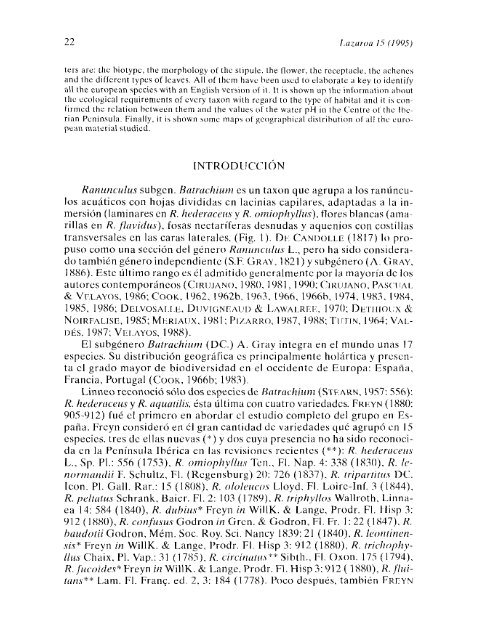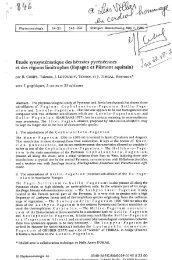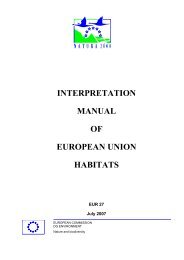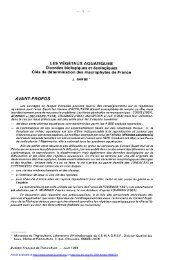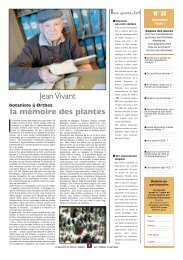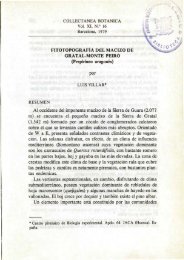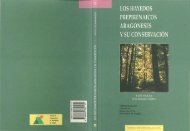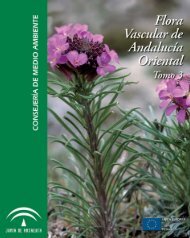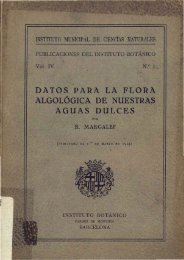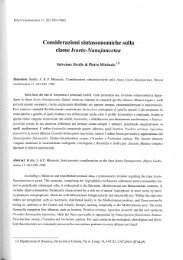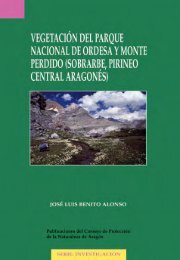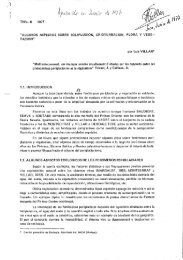Contribución al estudio taxonómico de Ranunculus L. subgen ...
Contribución al estudio taxonómico de Ranunculus L. subgen ...
Contribución al estudio taxonómico de Ranunculus L. subgen ...
Create successful ePaper yourself
Turn your PDF publications into a flip-book with our unique Google optimized e-Paper software.
22 1-a zaraa /5(1995)<br />
tcrs are: Lhe biatypc, the marphology of Lhe stipule. tite flower, the receptacle, Ihe achenes<br />
aud Ihe differeut types of caves. Ah of thcrn have beco used to elabarate a key tcí i<strong>de</strong>ntify<br />
‘<strong>al</strong>t the european species «iii> an Englis» version <strong>al</strong> it. II is sha»~n op lite inform<strong>al</strong>ion about<br />
tl>e ec<strong>al</strong>ogic<strong>al</strong> requireníents of every laxan wi t h rega rol tu t he type of habitat ancí it u s coso -<br />
firmed the relation between ohem aud the v<strong>al</strong>ues cíf the water pu in the ([entre of the beri<br />
an ¡‘e ninsula . Fin<strong>al</strong> ly, it iss hcíwu some ma ps cíf geographie<strong>al</strong> chistribution csf aH the euro—<br />
pean nsateriat studicd.<br />
1 NT RO D U CCI QN<br />
<strong>Ranunculus</strong> subgcn. Baíruchiuín es un taxon que agrupa a los ranunculos<br />
acuáticos con hojas divididas en lacinias capilares, adaptadas a la inníersión<br />
(lLíminares en R. he<strong>de</strong>raceus y 1?. omniophyllus). flores blancas (amarillas<br />
en R. jiavidus). fosas nectariferas <strong>de</strong>snudas y aquentos con costillas<br />
transvers<strong>al</strong>es en las caras later<strong>al</strong>es. (Fig. 1). Dr (?ANIOLLE (1817) lo) propuso<br />
como una sección <strong>de</strong>l género> Ranuncuhís L., pero ha sido> consi<strong>de</strong>rado<br />
también género in<strong>de</strong>pendiente (5.1’. CRAy, 1821) y subgénero (A. CRAY,<br />
1886). Este último rango es él admitido generainíente por la mayoría <strong>de</strong> los<br />
autores cO)ntempo)rLtneos (CIRIJJ,xNo. 198wos, 1988).<br />
El subgénero Butrachiurn (D(?.) A. Cray integra en el niundo unas 17<br />
especies. Su distribución geográfica es princip<strong>al</strong>mente holártica y presenta<br />
el grado níayor <strong>de</strong> biodiversidad en el occi<strong>de</strong>nte <strong>de</strong> Europa: España.<br />
Francia, Portug<strong>al</strong> (CooK, 1966b; 1983).<br />
Linneo reconoció sólo dos especies <strong>de</strong> Btu rachíuní (STEARN, 1957: 556>:<br />
1?. he<strong>de</strong>raceusyR. aquatilis. ésta última con cuatro varieda<strong>de</strong>s. FIZ¡-i’vN (1880:<br />
905-912) lué el primero en abordar cl <strong>estudio</strong> completo <strong>de</strong>l grupo en España.<br />
Freyn consi<strong>de</strong>ró en él gran cantidad <strong>de</strong> varieda<strong>de</strong>s qué agrupó en 15<br />
especies, tres <strong>de</strong> ellas nuevas (5’) y dos cuya presencia no ha sido recono)ctda<br />
en la Península Ibérica en las revisiones recientes (~~): R. he<strong>de</strong>raceus<br />
L., Sp. PI.: 556 (1753). R. omiophyllus Ten., FI. Nap. 4:338 (1830). R. lenorrnand¿¿<br />
F. Scliultz, FI. (Regensburg) 20: 726 (1837). 1?. íripartitus DC.<br />
Icon. PI. C<strong>al</strong>I. Rar.: 15 (1 8


